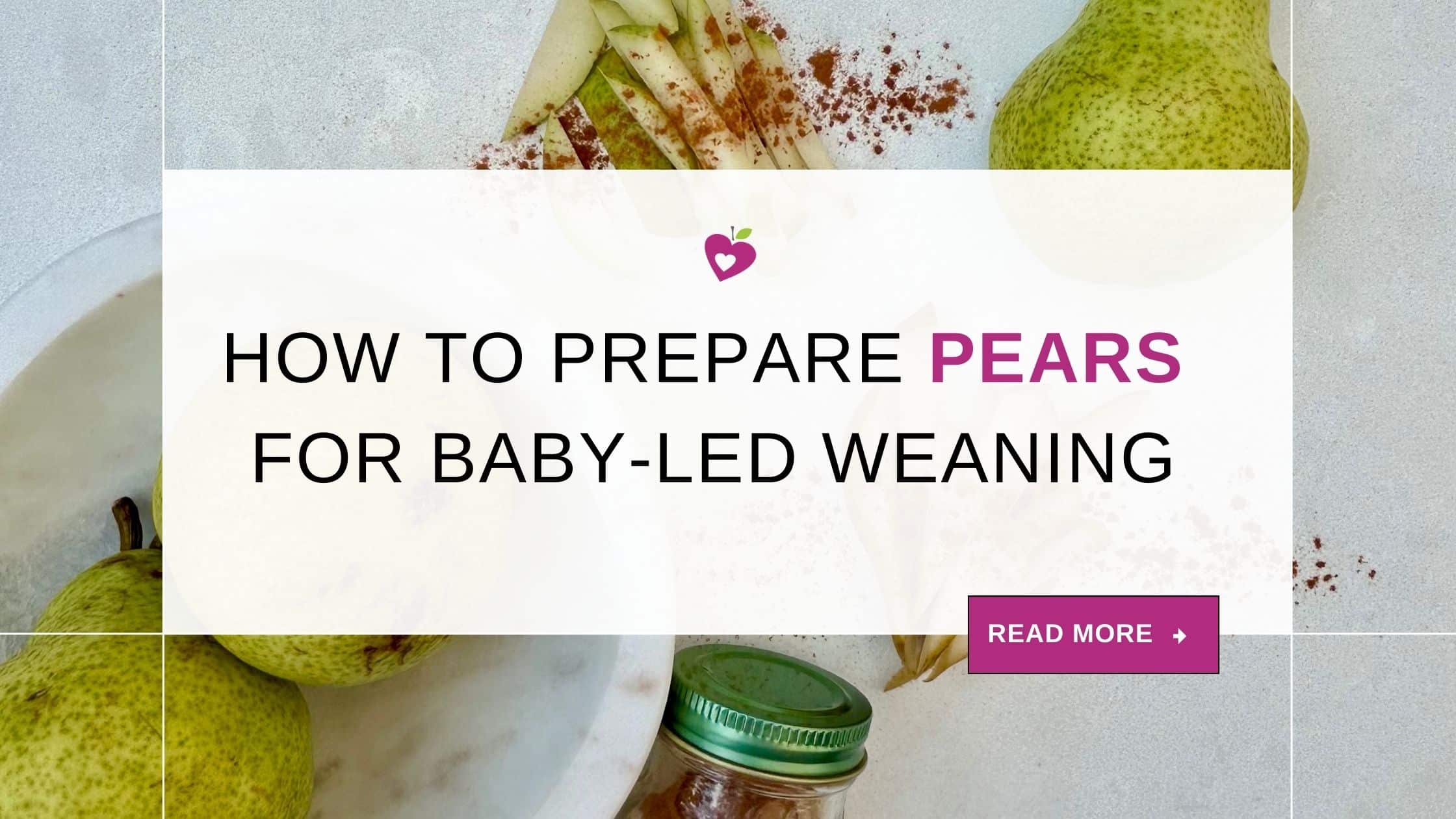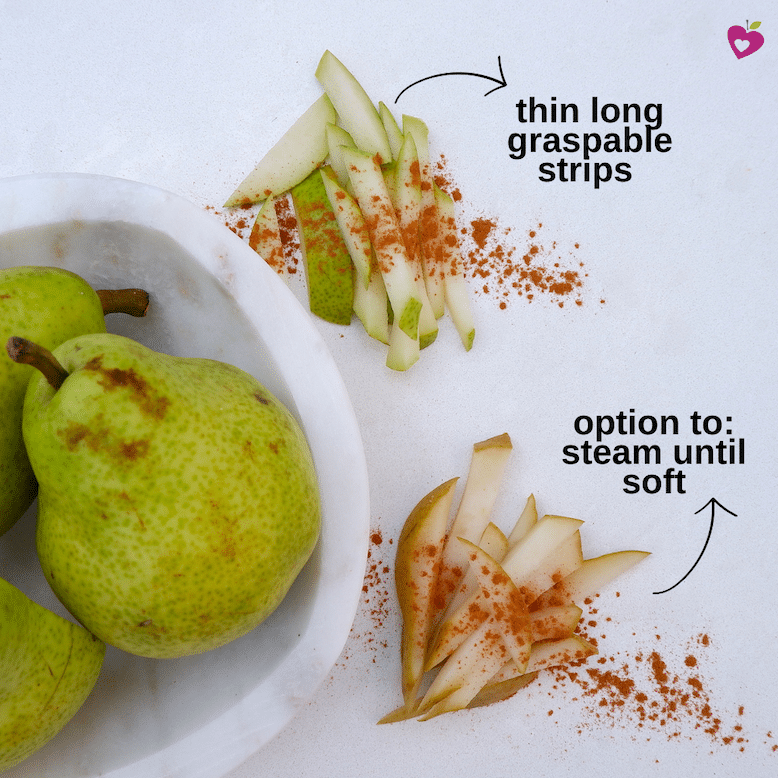
How to Prepare Pears for Baby-Led Weaning
Curious if your baby is ready to eat pears? Get expert tips from a dietitian about how to serve pears during baby-led weaning!
Introducing solid foods to your baby is an exciting milestone, and baby-led weaning (BLW) can be a fantastic way to encourage independence and healthy eating habits. Pears are a nutritious and delicious option for your baby.
But how do you prepare and serve pears safely during baby-led weaning? In this guide, we’ll cover everything you need to know about introducing pears to your baby’s diet as a finger food.
Benefits of Pears for Babies
Pears offer numerous health benefits for your baby, including:
- Rich in Fiber: Pears are high in dietary fibre, promoting healthy digestion and preventing constipation. Constipation is common when starting solids; here are some tips to deal with constipation for your baby.
- Vitamins and Minerals: Pears are an excellent source of potassium, vitamins C and K and potassium, supporting overall health and development. A source of vitamin C is great to serve alongside a source of iron, to increase iron absorption.
- Antioxidants: Pears contain antioxidants like phytochemicals and flavonoids that help protect cells from damage.
When Can Babies Eat Pears?
Babies can typically start eating pears around six months of age, which is the recommended age to start solid food. However, ensuring your baby is showing signs of readiness for solid foods first is essential.
Look for these indicators for baby-led weaning readiness:
- Sitting up with minimal support: Your baby should be able to sit up independently or with minimal assistance to prevent choking.
- Good head and neck control: This is crucial for safe swallowing.
- Interest in food: If your baby is reaching for food and seems curious about what you’re eating, it’s a good sign they’re ready to try solids.
How to Serve Pears During Baby-Led Weaning
Pears can be served in various ways, depending on your baby’s age and development. Here are some safe and effective methods:
Raw Pears
Ripe soft pears do not need to be cooked. A good test is to see if you can mash a piece of pear between the roof of your mouth with your tongue. If so, it will be easy for a toothless baby to mash with their gums (which are stronger than you might think!).
- Whole Pears: For babies with strong grips, offering a whole pear (with the skin removed) can be a good option. Ensure the pear is ripe and soft to prevent choking.
- Sliced Pears: Cut the pear into slices or wedges your baby can grasp. Ensure the pieces are large enough for your baby to hold and chew safely. If they’re too slippery to grasp, roll the pear slices in fortified infant cereal, ground flax or ground nuts.
- Grated Pears: Once your baby has developed a pincher grasp, you can grate raw pears. Use a firmer pear so it doesn’t go to mush, keep the peel on and offer your baby the shreds.
Cooked Pears
For unripe pears or harder varieties of pears, you can cook them for your baby before serving.
- Steamed Pears: Steaming pears softens them, making them easier for your baby to chew. Cut the pear into thin slices or wedges and steam in a stovetop or microwave steamer with a bit of water until soft.
- Baked Pears: Baking pears can enhance their natural sweetness. Slice the pear, place it on a baking sheet, and bake at 350°F (175°C) for about 20 minutes or until soft.
- Pear Puree: You can always puree the cooked pear, even if you’re doing baby-led weaning. Offer baby a pre-loaded spoon or a dipper spoon or get brave and let them use their hands to self-feed!
Choking Tips
To avoid choking, serving soft foods in a safe shape is essential. Soft foods are easier to cough up if your baby chokes. Round-shaped foods that can get lodged in the windpipe are unsafe.
While unlikely, if you offer your baby a whole pear that’s hard, they could bite off a round piece and choke. Use the serving suggestions above and follow the additional tips below to prevent choking.
- Always supervise your baby while eating. Choking is silent.
- Allow your baby to self-feed. Don’t put food in their mouth; we want them to have full control.
- Seat baby safely. Make sure your baby is supported in their chair, including a footrest.
- Remove distractions so your baby can focus on eating.
Read this post for more information on baby-led weaning and choking.
Additional Tips when serving pears to babies
- Skin Removal: For young babies, the safest form will be a peeled pear, to make it easier to chew. As they grow older and develop better chewing skills, you can leave the skin on for added fibre.
- Ripeness: Choose ripe pears that yield slightly to pressure. Overripe pears can be too mushy and hard to handle, while underripe pears can be too hard and pose a choking risk.
- Additional flavour: feel free to sprinkle on spices you feel might complement the pears, such as cinnamon. Extra taste and flavour exposure during childhood may help prevent picky eating later on.
Final Thoughts on pears for baby
Pears can be a delightful and nutritious addition to your baby’s diet during baby-led weaning. By following these tips and serving suggestions, you can ensure your baby enjoys pears safely.
For more information on Baby-led Weaning, grab my free guide: “7 easy baby-led Weaning Recipes your little one will love.”
Founder of First Step Nutrition | Registered Dietitian Nutritionist
Jen believes raising happy, well-nourished eaters who have a healthy relationship with food doesn't have to be a battle! She is an author and speaker with 18 years of experience specializing in family nutrition and helps parents teach their kids to try new foods without yelling, tricking, or bribing.







No Comments